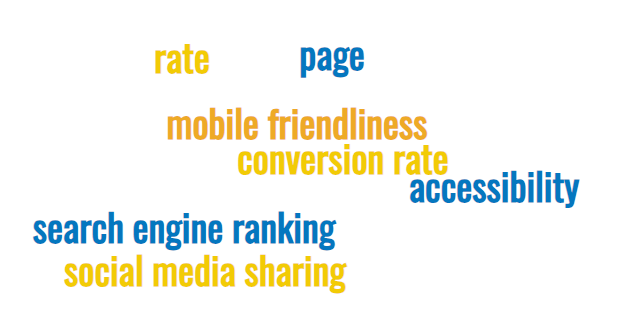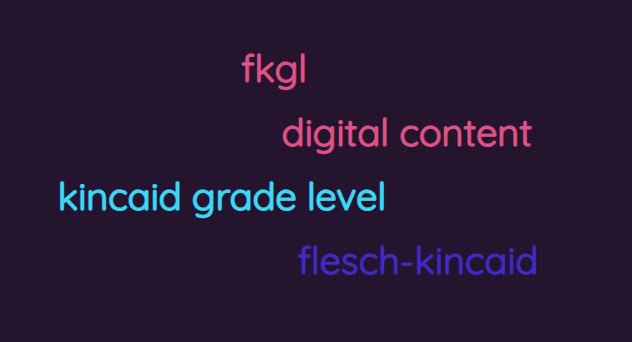The Flesch-Kincaid Grade Level (FKGL) is a tool that rates the difficulty of written material. Originally used for print, the FKGL also assesses digital content. The FKGL uses sentence length and word complexity to score text. It shows the least education needed to understand the text. It works by calculating averages — the words in each sentence and the syllables in each word. From these, it generates a grade level.
Applying the Flesch-Kincaid Grade Level to Digital Content
The formula focuses on sentence structure and word choice because these elements are pivotal to understand content.
1.
Sentence structure influences readability as it determines how easy or difficult it is to follow the writer’s flow of words and ideas. Online reading favors brief sentences. Lengthy, confusing sentences can trouble readers. The FKGL formula encourages using more short sentences than long ones.
The FKGL formula will yield better results if you learn to self-edit your sentence length.
Before: “Our advanced software solutions offer cutting-edge capabilities to facilitate seamless integration across various platforms, enabling synergistic collaboration and enhanced productivity.”
FKGL Score: 24.07
Reading Difficulty: Extremely Difficult
Grade Level: College Graduate
Age Range: 23+
1 sentences | 54 syllables | 20 words
After: “Our software syncs with numerous platforms, enhancing teamwork and efficiency.”
FKGL Score: 11.91
Reading Difficulty: Difficult
Grade Level: Twelfth Grade
Age Range: 17-18
1 sentences | 10 words | 20 syllables
Before: “The study utilized a stratified random sampling technique to select participants from diverse backgrounds, ensuring a representative sample.”
FKGL Score: 15.69
Reading Difficulty: Extremely Difficult
Grade Level: College Graduate
Age Range: 23+
18 words | 1 sentences | 37 syllables
After: “We chose people from diverse backgrounds using a fair sampling technique.”
FKGL Score: 5.86
Reading Difficulty: Fairly Easy
Grade Level: Sixth Grade
Age Range: 11-12
11 words | 1 sentences | 16 syllables
Before: “While I had been thinking about the various ways in which we could potentially address the issue, I realized that perhaps the most straightforward solution might be the best one.”
FKGL Score: 12.24
Reading Difficulty: Difficult
Grade Level: Twelfth Grade
Age Range: 17-18
30 words | 1 sentences | 41 syllables
After: “I thought about many solutions. The simplest seemed the best.”
FKGL Score: 2.88
Reading Difficulty: Very Easy
Grade Level: Third Grade
Age Range: 8-9
10 words | 2 sentences | 14 syllables
Before: “Due to the fact that it is a rather complex process, it is of utmost importance that we carefully consider each step.”
FKGL Score: 10.69
Reading Difficulty: Fairly Difficult
Grade Level: Eleventh Grade
Age Range: 16-17
22 words | 1 sentences | 33 syllables
After: “It’s a complex process. We must think about each step.”
FKGL Score: 2.88
Reading Difficulty: Very Easy
Grade Level: Third Grade
Age Range: 8-9
10 words | 2 sentences | 14 syllables
Before: “Even though it is often assumed that those who reside in urban areas would have better access to resources, this is not always the case.”
FKGL Score: 10.68
Reading Difficulty: Fairly Difficult
Grade Level: Eleventh Grade
Age Range: 16-17
25 words | 1 sentences | 35 syllables
After: “People think city dwellers have more resources. This isn’t always true.”
FKGL Score: 3.72
Reading Difficulty: Easy
Grade Level: Fourth Grade
Age Range: 9-10
11 words | 2 sentences | 16 syllables
Before: “When one takes into consideration the various factors that contribute to success, it becomes clear that it is not solely dependent on intelligence, but also on a number of other factors.”
FKGL Score: 16.67
Reading Difficulty: Extremely Difficult
Grade Level: College Graduate
Age Range: 23+
31 words | 1 sentences | 53 syllables
After: “Many factors lead to success. It’s not just about knowledge.”
FKGL Score: 5.24
Reading Difficulty: Fairly Easy
Grade Level: Fifth Grade
Age Range: 10-11
10 words | 2 sentences | 16 syllables
2.
Word Choice and Vocabulary: The FKGL formula considers the average number of syllables per word as an indicator of word difficulty. Using simpler, more common 1-3 syllable words will make the text easier to understand and yield a better readability score.
Examples:
- “Utilize” (3 syllables/7 chars.) could be replaced with “use” (1 syllable/3 chars) for better readability.
- Instead of “subsequently” (4 syllables/12 chars.) using “next” (1 syllable/4 chars.) simplifies the text.
- Replace “acquire knowledge” (5 syllables/16 chars.) with “learn” (1 syllables/5 chars.) to make the sentence clearer.
- “Commence” (2 syllables/8 chars.) can be substituted with “start” (1 syllables/5 chars.) to make the text more accessible.
- Rather than “ameliorate” (5 syllables/10 chars.) use “improve” (2 syllables/7 chars.) to enhance understanding.
3.
Visual Layout and Formatting: The look and arrangement of digital content influence readability too. Features like font size, space between lines, headings, bullet points, and visual order affect how users navigate and grasp the text.
Examples:
- A blog post uses larger font size and bold headings to break up text and guide the reader.
- An educational webpage uses bullet points to list key facts, helping readers understand and retain information.
- An online magazine uses ample line spacing in articles, making the text easier to read.
- An e-book uses a clear visual hierarchy with chapters, sections, and subsections to guide the reader.
- A digital report utilizes charts and infographics to present complex data in an accessible way.
4.
Improving readability in the digital realm involves adjusting various elements to make the information more accessible and easier to understand. Usability is just as important as readability.
Multimedia Integration: Digital content often includes images, videos, and infographics. These can boost understanding and interest. When checking the overall readability, it helps to see how multimedia affects ease of reading.
Examples:
- A news website includes a video clip within an article, giving readers a more engaging understanding of the event.
- An educational blog post uses infographics to explain complex topics, making it easier for readers to grasp the information.
- An online cookbook features high-quality images of each recipe step, helping readers follow the instructions.
- A travel blog embeds a video tour of a destination, enhancing readers’ experience and understanding of the place.
- A business website uses an interactive chart to explain growth trends, making complex data more understandable for the audience.
User Experience: Readability links closely to user experience. Knowing your target readership, their knowledge of the topic, and reading preferences all lead to a detailed readability evaluation. User feedback, usability tests, and analytics also offer useful insights to enhance the readability check.
Examples:
- A website for children uses simple vocabulary, large font size, and bright colors, improving readability for its young audience.
- An academic journal site uses a clean layout, professional tone, and provides citation features, catering to its scholarly readers.
- A tech blog conducts a survey to collect user feedback on readability, then adjusts its content presentation based on the responses.
- A news site tracks analytics data showing that mobile users prefer shorter paragraphs, and adjusts its articles to enhance readability on mobile devices.
- An e-commerce site conducts usability tests, identifying that customers prefer product descriptions with bullet points for key features. They then adjust their product descriptions accordingly.
The Flesch-Kincaid formula can help improve your bottom-line website metrics.

Bounce Rate: High bounce rates often plague hard-to-read websites. This number shows the share of visitors leaving after seeing just one page. Clear, understandable content encourages users to stay, fostering a positive experience.
Time on Page: When content is easy to read, people tend to linger longer. Clear information holds user interest, thereby extending their time on the site.
Conversion Rate: Clarity can uplift conversion rates. Users are more likely to act—such as subscribing to a newsletter or making a purchase—if the message is quickly understood.
Mobile Friendliness: Given the dominance of mobile internet access, readability matters. The small screens and unique contexts of mobiles demand succinct, transparent information.
Accessibility: Good readability benefits those with disabilities or impairments. Such sites are more accessible, enhancing user experience for a broader audience.
Search Engine Ranking: Search engines prioritize user-friendly websites. Clear, engaging content minimizes bounce rates and boosts rankings.
Social Media Sharing: Easy-to-grasp content often gets shared on social media. Better readability can broaden your content’s reach, driving more engagement.
Case Study 1: E-commerce Website – ‘TechGadgets’
Background: ‘TechGadgets’ is an e-commerce website selling the latest technological gadgets. Despite having quality products, the website experienced high bounce rates and cart abandonment.
Challenge: The product descriptions were lengthy and filled with technical jargon. Average users couldn’t understand the product’s features and benefits, leading to confusion and hesitation in buying.
Solution: The company decided to rewrite their product descriptions using the FKGL as a guideline. They aimed for an eighth-grade reading level, simplifying jargon and shortening sentences.
Results:
- Bounce rate decreased by 25% in the first month.
- Cart abandonment rate dropped by 15%.
- Positive customer feedback increased, mentioning the ease of understanding product features.
- A 20% increase in sales over the next quarter.
Case Study 2: Healthcare Portal – ‘WellLife’
Background: ‘WellLife’ is a healthcare portal offering information on various diseases, treatments, and wellness tips. Although the portal had a wealth of information, user engagement was low.
Challenge: The articles on the website were written in a very clinical and academic tone, targeting medical professionals rather than the general public.
Solution: The company decided to restructure their content strategy. They employed the FKGL to assess and rewrite their articles, targeting a sixth to eighth-grade reading level. They made content more accessible to a broader audience.
Results:
- A 35% increase in average time spent on the website.
- 40% more article shares on social media platforms.
- A significant boost in monthly subscriptions to their newsletter.
- An increase in positive user feedback regarding the ease of understanding complex medical topics.
Case Study 3: Online Learning Platform – ‘LearnHub’
Background: ‘LearnHub’ is an online platform offering courses on various topics ranging from arts to sciences. They were facing challenges with course completion rates.
Challenge: Many users enrolled in courses but did not complete them. Feedback indicated that course materials, especially reading materials, were too complex.
Solution: The company used the FKGL to assess the readability of their course content. They revised course materials, aiming for a tenth-grade reading level because their demographic was mainly adults.
Results:
- Course completion rates saw an increase of 30% over the next six months.
- User reviews indicated better comprehension and enjoyment of course content.
- Referral rates increased, with more users recommending the site’s courses to peers.
- A decrease in user queries and complaints about course content complexity.
Remember: easy-to-read content, in print or digital, will help you reach a broader audience and make your message more accessible. Use the The Flesch-Kincaid and other readability formulas to know just how readable your text is.






